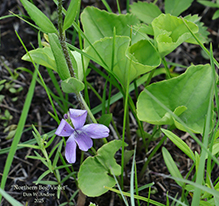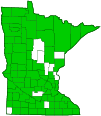northern bog violet
(Viola nephrophylla)
Conservation • Weed • Wetland • Description • Habitat • Ecology • Use • Distribution • Taxonomy
Description |
Northern bog violet is one of several similar blue violets native to North America. In the western United States, it occurs from the Cascades and Sierra Nevadas east to the edge of the Great Plains. In the eastern U.S., it is most common from Maine and Vermont west to Minnesota and Iowa, but it also occurs as far south as North Carolina and Texas. It occurs across southern Canada from Nova Scotia to eastern British Columbia. Northern bog violet is found in wet habitats, including pastures, bogs, fens, sedge meadows, and shores of lakes and streams. It grows under full sun to light shade, in saturated, loamy soil. Northern bog violet is a perennial, 2″ to 6″ (5 to 15 cm) tall, herbaceous plant. It has no aerial stem. A rosette of 4 to 7 basal leaves and one or more flowering stalks rise directly from a thick underground stem (rhizome). The rhizome is prostrate or slightly ascending and ⅛″ to ¼″ (4 to 6 mm) thick. The basal leaves rise directly from the rhizome on ¾″ to 10″ (2 to 25 cm) long leaf stalks (petioles). The petioles are usually hairless. At the base of each petiole is a pair of conspicuous leaf-like appendages (stipules). The stipules are less than ⅝″ (15 mm) long, and they are completely separated from the petiole. They are lance-shaped and narrowly pointed at the tip. The margins are untoothed. The texture is membranous to somewhat herbaceous. The leaf blades are fleshy and egg-shaped, kidney-shaped, or broadly kidney-shaped to almost circular. They are unlobed, heart-shaped at the base, and usually narrowly or broadly pointed, sometimes rounded, at the tip. The margins are finely toothed or scalloped for their entire length. The underside is usually grayish green or purplish green. The upper and lower surfaces are usually hairless, rarely sparsely hairy. The inflorescence is a single flower at the end of a usually hairless, 1¼″ to 10″ (3 to 25 cm) long stalk (peduncle). The flowers rarely overtop the leaves. Two types of flowers are produced: open, cross-pollinated (chasmogamous) flowers are produced in the spring; and closed, self-fertilizing (cleistogamous) flowers are produced in the summer. Cross-pollinated flowers are ¾″ to 1¼″ (2 to 3 cm) long and wide. There are 5 sepals, 5 petals, 5 stamens, and 1 style. The sepals are green, oblong, and less than ⅝″ (15 mm) long. There is a pair of inconspicuous, 1⁄64″ to 1⁄32″ (0.5 to 1.0 mm) long, ear-like projections (auricles) at the base. The petals are usually bluish purple or purple on both surfaces. There are 2 upper petals, two lateral petals, and 1 lower petal. The upper petals are sometimes sparsely bearded. The lateral petals are white at the base and are heavily bearded. The lower petal is white at the base with dark violet veins. It is bearded, but it may appear beardless because the beard is deep in the throat of the flower. It has a rounded spur at the base that usually extends well beyond the auricles at the base of the sepals. The 5 stamens have very short filaments. They do not protrude from the throat of the corolla and usually cannot be seen without dissecting the flower. The flowers are not fragrant. Self-polinated flowers are on slender, erect or strongly ascending peduncles. The fruit is an egg-shaped to ellipse-shaped, 3⁄16″ to ⅜″ (5 to 10 mm) long, hairless capsule with many beige to brown or dark brown seeds. |
Height |
2″ to 6″ (5 to 15 cm) |
Flower Color |
Bluish purple or purple |
Similar Species |
Common blue violet (Viola sororia) leaf blade is not fleshy, the underside is green, and both surfaces are usually hairy. It occurs in dry or moderately moist areas, not in saturated soils. |
Habitat |
Wet. Pastures, bogs, fens, sedge meadows, and shores of lakes and streams. Full sun to light shade. Saturated loamy soil |
Ecology |
Flowering |
April to July |
Pests and Diseases |
|
Use |
|
Distribution |
||
|
Sources Biodiversity occurrence data published by: Minnesota Biodiversity Atlas (accessed through the Minnesota Biodiversity Atlas Portal, bellatlas.umn.edu, 6/29/2025). |
|
| 6/29/2025 | ||
Nativity |
||
Native |
||
Occurrence |
||
Common |
||
Taxonomy |
|
Kingdom |
|
Subkingdom |
Pteridobiotina |
Phylum |
Tracheophyta (Vascular Plants) |
Class |
|
Order |
Malpighiales (Nances, Willows, and Allies) |
Family |
Violaceae (violet) |
Subfamily |
Violoideae |
Tribe |
Violeae |
Genus |
Viola (violets) |
Subgenus |
Viola (pansies and violets) |
Section |
Nosphinium |
Subsection |
Borealiamericanae (eastern American blue violets) |
Sand Violet? All other sources checked treat this taxa as Viola nephrophylla. These sources include |
|
BONAP Catalogue of Life Flora of North America GBIF iNaturalist Manual of Vascular Plants of Northeastern United States and Adjacent Canada (Gleason & Cronquist) Michigan Flora (Voss) Minnesota Flora (Chadde) NatureServe NCBI Plants of the World Online Steyermark’s Flora of Missouri (Yatskievych) The IUCN Red List of Threatened Species USDA PLANTS World Flora Online |
|
Subordinate Taxa |
|
|
|
Synonyms |
|
Viola arizonica Viola austinae Viola austiniae Viola cognata Viola galacifolia Viola lunellii Viola maccabeiana Viola mccabeiana Viola nepetifolia Viola nephrophylla var. arizonica Viola nephrophylla var. cognata Viola nephrophylla var. nephrophylla Viola peramoena Viola subjuncta Viola vagula |
|
Common Names |
|
Leconte violet northern bog violet wild violet |
|
Glossary
Auricle
A small, ear-like projection at the base of a leaf or at the junction of a grass blade and stem.
Bearded
Bearing one or more tufts of hairs.
Cleistogamous
Automatically self-pollinating. Refers to bud-like flowers that do not open but automatically self-pollinate, or to plants with such flowers.
Membranous
Thin, pliable, and more or less transparent.
Petiole
On plants: The stalk of a leaf blade or a compound leaf that attaches it to the stem. On ants and wasps: The constricted first one or two segments of the rear part of the body.
Rhizome
A horizontal, usually underground stem. It serves as a reproductive structure, producing roots below and shoots above at the nodes.
Stipule
A small, leaf-like, scale-like, glandular, or rarely spiny appendage found at the base of a leaf stalk, usually occurring in pairs and usually dropping soon.
Visitor Photos |
||
Share your photo of this plant. |
||
This button not working for you? |
||
Dan W. Andree |
||
 |
 |
|
Northern Bog Violet It was hard to find any with a blossom just noticed the plants … |
||
Another Northern Bog Violet... Not sure but maybe they are done blooming for the season. They were in a previous prescribed burn area out there. They did a prescribed burn on maybe half the TV SNA and burned out the entire adjacent larger Twin Valley Prairie sometime this early Spring 2025. But I had to really look to find any violets blooming. |
||
|
||
|
||
|
||
|
||
MinnesotaSeasons.com Photos |
||
|
||
|
||

Slideshows |
|

Visitor Videos |
||
Share your video of this plant. |
||
This button not working for you? |
||
|
Other Videos |
||
Northern bog violet, violette néphrophylle - Viola nephrophylla |
About
Jun 1, 2024 Locality - 50.018063, -96.941571 https://www.inaturalist.org/observations/219574166 Date - 26 May 2024 Voice - the boreal chorus frog (Pseudacris maculata) |

Visitor Sightings |
||
Report a sighting of this plant. |
||
This button not working for you? |
||
Dan W. Andree |
Location: Twin Valley Prairie SNA Not sure but maybe they are done blooming for the season. They were in a previous prescribed burn area out there. They did a prescribed burn on maybe half the TV SNA and burned out the entire adjacent larger Twin Valley Prairie sometime this early Spring 2025. But I had to really look to find any violets blooming. |
 |
Dan W. Andree |
Location: Twin Valley Prairie SNA It was hard to find any with a blossom just noticed the plants … |
 |
MinnesotaSeasons.com Sightings |
||

|
Created: 6/29/2025 Last Updated: © MinnesotaSeasons.com. All rights reserved. |
